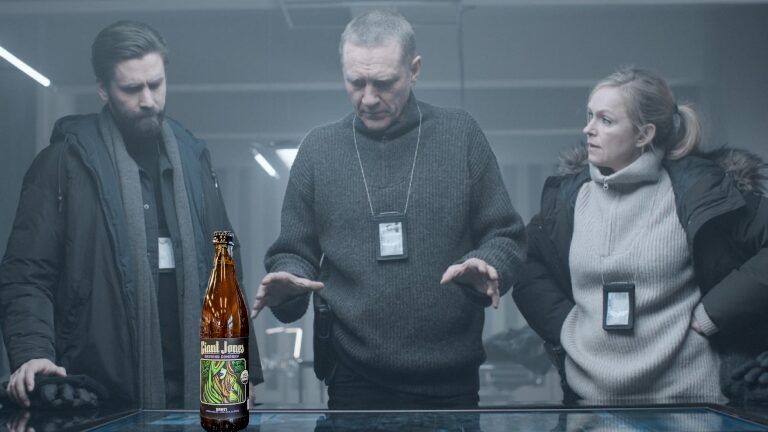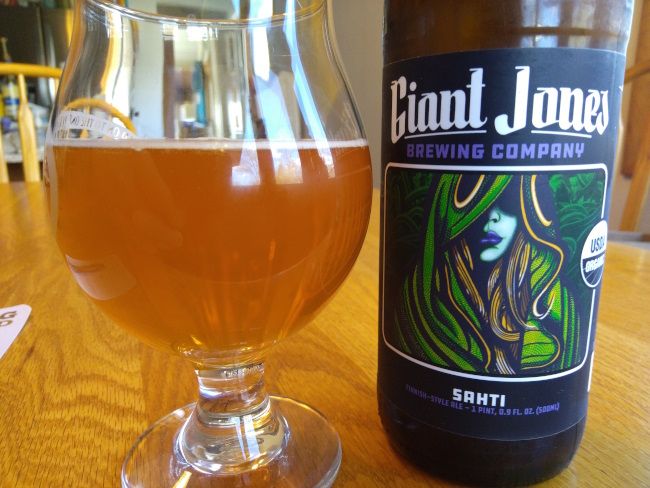...during a very cold winter.
Back in their home village, their friend Matti began to get worried about them not returning so he decided to send a trained dog to rescue them. He attached a barrel of vodka to the dog and asked it to find his friends.
Pekka and Jukka were sitting around a camp fire, drinking, when the dog found them. Pekka shouted: “Oh there is the rescue, our best friend coming towards us... But, hold on, what an earth is attached to it?”. “Can't you see?”, answered Jukka, “It is Matti's dog!”
Several years back when I first started to investigate Scandi-noir, I noticed that police stations in Finnish shows such as Bordertown - see above - were these late-20th century bunker-like affairs. Dark, shadowy places with not a window to be seen so there was no natural light, just the fluorescent stuff. A bit like the Humanities building here on the UW campus. This stood in stark contrast to a French cop show called Spiral that I watched around that time where the cop shop was in an old building with open windows everywhere letting in plenty of sunlight and venting all the cigarette smoke as a "Voltaire slept here" sign hung from a wall in the background.
Finnish cops, when not sitting in a sauna, were always dressed for the cold and snow and seemed ready to defend themselves from murderous reindeer. French cops, on the other hand, were mostly a bunch of bon vivants who wore berets and dipped baguettes into their wine as they puzzled out the next steps of their investigations and quoted Sartre at one another. Finns were serious and taciturn, if not outright dour, while the French were convivial and determined not to let a little thing like murder get in the way of a good time. Plus the French weren't as pale.
But it is the Finns who give us the beer that is sahti. Filtered through spruce boughs and generally made with bread yeast, it smacks of the Finns' boreal homeland and its hardy, unpretentious inhabitants.
A few months back in December I reviewed Giant Jones' Norwegian farmhouse ale, Kornøl. I noted then that Giant Jones also had a sahti on offer and that I hoped to be able to sample it. Well, I finally managed to do so. The thing about Giant Jones' beers is that they're all rather potent so, if you buy some that was bottled in August but don't get around to drinking it until several months later in March, it'll still be good.
Sahti seems to come in the 8%-10% range in its homeland, though there are certainly less potent variations. Rye is common but not all sahti brewers use it. Hops, from what I can tell, are minimal to non-existent. Spruce branches are traditionally used when filtering out the grain but I have read that juniper branches are also used. Sometimes branches are left out completely and berries do all the work. And so Giant Jones had lot of leeway when brewing their Finnish-style ale.
When I think of farmhouse type ales, I think of something unfiltered because it's beer brewed in primitive conditions for immediate or near immediate consumption. This sahti had the right look, to my eyes, with a substantial haze taking the shine off of the yellow liquid. (It appeared gold in the thicker part of the glass.) A tiny white head didn't take long to disappear while I spied a modicum of bubbles through the haze.
The aroma was like a hefeweizen with a prominent banana scent joined by a bit of bubblegum. A hint of something piney hovered in the background.
Beers with a cloudy appearance and/or having a lot of alcohol tend to have heavier bodies but I found the sahti to have a nice medium-light one instead. Fizz was of a similar intensity so it was rather smooth. The aroma bits swapped places here with bubblegum becoming more prominent than banana. There was a bit of rye plus a peppery tasting hoppiness to offer spicy counterpoint to the fruity yeast flavors and the (tempered) grainy sweetness.
Upon swallowing, a pine flavor came through - the stuff was filtered through spruce branches, if memory serves. Not strong but instead deliciously subtle. The yeast and grain flavors departed quickly allowing those peppery hops to take over and make for a rather dry finish with a modicum of bitterness.
I found that, when drunk cold, Sahti has more of a hefeweizen character minus the wheat. Those yeasty banana/bubblegum flavors had center stage. However, as the brew warmed, it lost some of the lighter, fruitier flavors and took on mellow, earthy ones with the hops, rye, and spruce coming together for a taste that was heartier, more redolent of a farmhouse.
And it was this flavor triad that makes Sahti such a great beer. They all came in just the right amounts and melded together just perfectly.
Junk food pairing: Crank up the Sibelius, pour a glass of Sahti, and grab a bag of Gardetto's Roasted Garlic Rye Chips.


No comments:
Post a Comment